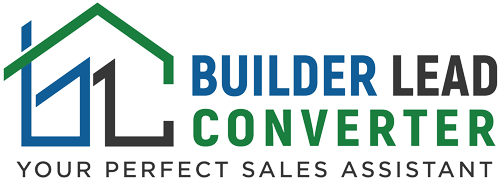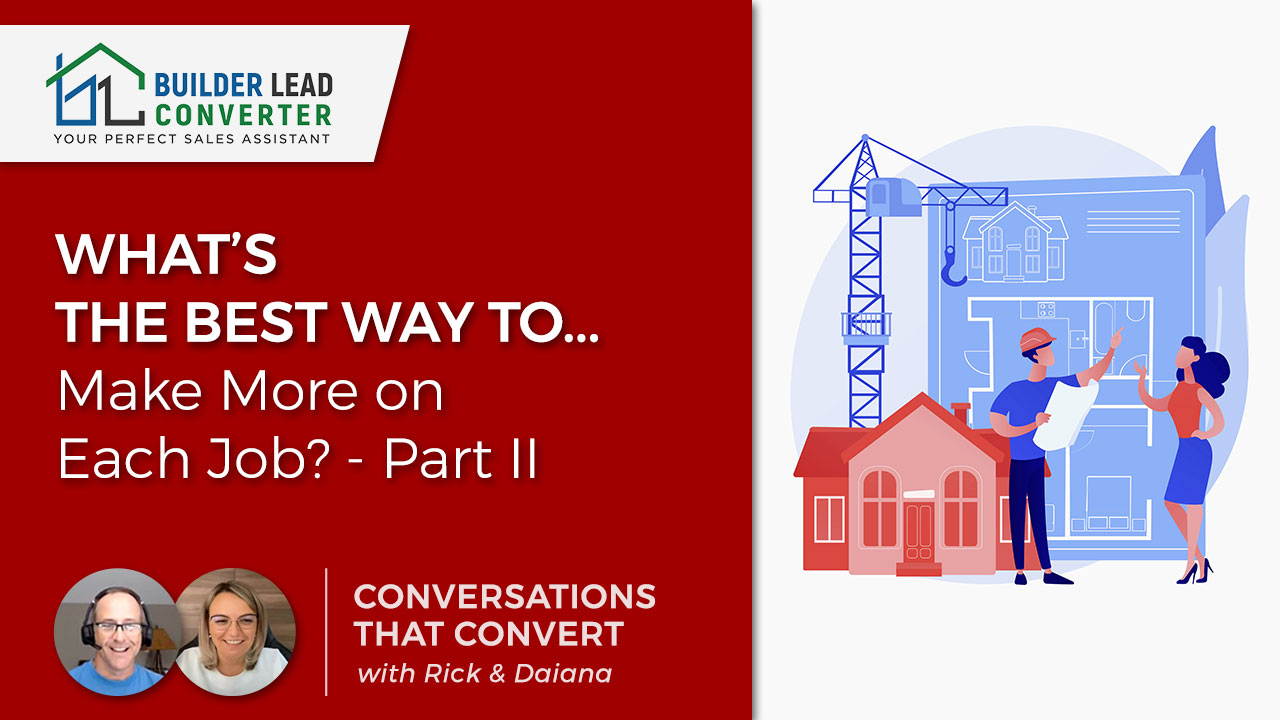Builders have been asking the question , ‘What’s the best way to make more money on each job?’. If you’ve been searching for an answer, then read on!
In part II of this series, we reviewed the SINGLE BEST MARKETING TACTIC every builder needs to employ to help your prospects not only choose you, but to pay more doing it.
Read/Watch/Listen on to discover strategies for smarter job costing that guarantee success!
Builder Lead Converter captures & converts leads for home builders & remodelers so they can grow sales revenue and margins. Find out how at https://www.builderleadconverter.com
Transcript:
Rick: Today In Conversations That Convert, we’re gonna talk about what is the best way to make more on each job. This is part two of two. Let’s go ahead and get started.
Welcome to Conversations That Convert. Every week, we’ll spend about 10 to 15 minutes tackling relevant lead generation, marketing, and sales topics for remodelers, home improvement companies, and home builders. Conversations That Convert is brought to you by Builder Lead Converter, your perfect sales assistant. And now here’s Rick and Daiana.
Rick: Good day everyone. Welcome to Conversations That Convert. Daiana, how are you?
Daiana: And very good. Welcome. Welcome to Conversations that Convert.
Rick: Nice to see you again. I’m very excited about today’s show. Daiana. So what are we talking about?
Daiana: Today we have, we have a nice conversation. This is part two of what a builder can ask about what’s the best way to make more on each job. More?
Rick: That’s right.
Daiana: And more
Rick: That age-old question is, hey, if I’m gonna be doing the job, how can I make more on this job? And this is part of our series where builders ask us the most frequently asked questions as to what is the best way to, so here we’re gonna talk about getting into marketing, and this is again, this part two of two. So if you haven’t seen last week’s video, make sure you go back there and check it out. We’ll put a link in the description below, but check that out so you understand it. We’re gonna give a little bit of an overview here before we jump into today’s topic. And so let’s talk a little bit more about marketing, shall we, Daiana?
Daiana: Yes. Let’s see. What was the previous discussion?
Rick: Exactly. This is a definition from Investopedia. So marketing is the activities the process a company undertakes to promote the buying or selling of a product or service. So oftentimes marketing people talk about marketing as like lead generation, which is really more advertising or client acquisition. But it’s really everything you do to promote the buying or selling of your product or service. So here’s a question, Daiana. So what happens to trigger a lead to become a buyer? Any ideas?
Daiana: To force the lead to become a buyer?
Rick: My gunpoint.
Daiana: Yeah.
Rick: Yeah, so it’s, but the answer is somewhat simple, but you know, a lot of times people don’t really think about it. Why do some people buy and some people don’t? Well, the answer is, is that trust has been established. The buyer perceives that you are offering, or the builder’s offering is equal to or greater than the price being asked. So I always have this visualization of where there’s a big pile of money in front of the buyer and the builder has a scope of work for services and materials they’re going to use, and there’s an exchange that happens. So as soon as that buyer feels that what they’re getting in return is equal to or greater than the amount of money that they are exchanging, this sale is made. So, trust, we talked a little bit about last week. If they don’t trust you, the sale’s not gonna be made. And we joked a little bit too, Daiana, about how some guys like, you know, they think if they’re getting a good enough deal, but they don’t really trust the guy. You know, they might buy, but there’s no way a woman is going to hire a builder she doesn’t trust. What do you think of that?
Daiana: I totally agree. And the women will take the decision, right?
Rick: That’s right. Women are primary decision-makers. And you’ve just been through a couple of remodeling projects and I think you fired your last remodeler, did you not? Because you really didn’t trust that they were, would do what they said they were gonna do?
Daiana: Yes. and somehow I have a good intuition. So I don’t know how, but I can, I can read the builder.
Rick: Well, very good. You might be able to hire, you might be able to work as a consultant for some of these clients looking higher. So let’s talk about value as an equation. So it’s a very simple price performance. That’s a price that you ask versus the quality perception of your lead. So it’s the price you are asking whatever that dollar amount is versus what your lead perceives they are getting in return. So again, when those two things are equal, value is established. As long as the trust is established, the sale is made. If the price performance is greater than the quality, the sale is not made. However, if the quality perception is greater than price performance, the sale is still made because they feel like they’re getting more in return than they’re actually giving. So there’s you a quick lesson on, on, on value. So we’re gonna, you know, really break down this definition a little bit more for home building, but marketing is simply the process. of establishing value for your product or service. Again, it’s a process. So I understand you have a question for me, Daiana.
Daiana: Yes. How does a builder create value for their service?
Rick: Well, what a wonderful, smart-pointed question.
Daiana: Thank you.
Rick: This is, it’s, this sounds like so cliche, but the answer is so simple. You tell stories.
Daiana: Yes.
Rick: You tell stories. I mean, everybody gets so, you know, like, oh, I need to do this and this and this and make it so complicated. No, it’s not complicated. You’re simply telling stories. That’s the most powerful thing you can do in marketing your business and making more from each job. So, should we break that down a little bit, Daiana?
Daiana: Yes. I love stories. I’m looking.
Rick: Yeah. You love stories and you know what, and you, I know you had something too, you wanted, you, you wanted to mention about telling stories.
Daiana: Yeah, when you mentioned stories, my, my mind goes to, to the classical comedies, movies, when you, you have the same script. If you, if you look from above and the fairy tales and it’s, it’s a story and they have a script and something, it’s happening and then we have a happy ending. And, it’s.
Rick: Yeah, exactly. In every great movie, book, every great documentary it does, there’s the same common denominator. It tells a great story, and there is a formula for that. So we’re gonna go ahead and talk about that, that formula. But before we jump into that, stories create value in two ways. Okay? So first of all, it shows that you as the builder, understand your client’s problems or pain points. And the second way that stories create value is it demonstrates your expertise in solving problems. So two things that a story will do, so first of all, let’s talk about the pain point. So a pain point is the before. So what was your client struggling with? Before they decided to build a home or remodel their current home, what was missing in their hoped-for lifestyle? We talked about hope for lifestyle last time. Lifestyle, in my opinion, is what you are selling. You are selling a lifestyle. It’s not sticks and bricks. You’re not building homes, you’re not remodeling homes. You are selling a lifestyle, that is your product, okay? Your service is the process you go through to help them achieve that hoped-for lifestyle. But Daiana, you remodeled recently a couple of times. Can you relate to this?
Daiana: Yes, so, I can definitely feel the pain of before, and then I wanted a nice lifestyle and have a good sensation when I’m entering the home and, just feel good.
Rick: Absolutely. So let’s talk a little bit more now about the solution. So we talked about pain points as the first way a story helps you connect with your potential client. The second way is your solution. The solution is going to be comprised of two or three parts. If you’re a home builder, it’s gonna be based on a location. So, the client wants to be in a specific location because of many factors, accessibility, and proximity. The second though, and third ways are both applicable to both home builders and remodelers. So number one is designed. So how do you design that new space? And then number two is gonna be the products that you suggest that we’re gonna, will work with the design, will help give those final, you know, that cherry on the top, of that remodeler new home Sunday. But those little bells and whistles that the products that you suggest can go in there. So it’s location design and products. Obviously, location is not part of remodeling. Any thoughts there, Daiana?
Daiana: So I think that that makes sense. And now I can more relate to the design part.
Rick: Mm-mmm.
Daiana: So it’s, it’s, but they’re all, all very important depending on, in the, in the stage you are, you are.
Rick: Design is so important because the one thing that as humans we lack, is normally the ability to visualize what it will look like.
Daiana: Yeah.
Rick: We all struggle with that. So your clients come to you with the same three questions. They wanna know, what will it look like if they’re building, they wanna know where they can build it. And then the last question they always ask is, how much will it cost?
Daiana: Yeah.
Rick: So that’s why people always start by looking at your photos or looking at your floor plans. They wanna look at your videos of your, of your finished product because they can’t visualize what their home will look like. So a design is really, really powerful. It’s a huge emotional. The connection that you as a builder make with your lead. So what do you say, Daiana? Should, should we talk about how to tell a client story?
Daiana: Yes. Where it’s, I believe it’s a beginning and middle and an end.
Rick: Exactly. Just like we’re gonna create, create a great movie. We gotta, we gotta write that script, which is the ultimate, how are we gonna tell the story, to the, to the audience in order to keep them compelled and emotionally attached to, to the story. So there are really three parts to the story. So the first part we are, we will begin with is the problem. Then we will look at agitating that problem. Then we introduce a solution, and then we have, with a CTA, we call that a call to action. That’s your formula, so telling one of your client’s stories you always start with, where were they? So this is before the build. That’s the problem. The agitation would come from. What were they unable to do because they didn’t have a home that met the needs of their lifestyle? You as the builder are the solution. Okay, so that’s, you came in and said, well, we can do this. So if you’re remodeling at home, you say, this is how we repurpose this space. Maybe you added an addition. If you’re building a home, you’ll talk about the floor plan they selected, or the custom design process that you went through to create that space that’s gonna be a perfect fit for their lifestyle. And then the last thing is to call to action. That’s what most builders forget, are you need to tell the lead at this point what you want them to do, because what you’re doing in this, through this formula is you’re getting the lead to say, wow, this person had the same problems that I do. Okay? So they’re going to become aware. And then when you agitate the problems, then that creates that real emotional attachment. So now they’re aware that you can help people just like them. Those people had some of the same agitations that you did. If you can solve the problem for this other person, that means you can solve it for me. And then their next question is, well, what’s the next step? I love that you’ve ever been with somebody, Daiana, and they, and they ask you, look, oh, this sounds great, Daiana, what’s the next step? You know?
Daiana: Yeah.
Rick: That’s, you know, like, okay, stop selling, right? Let’s just move to the next step. So that’s what we’re talking about here, is we’re gonna tell ’em what the, what the next step is. So that’s, that’s the first part of telling a client’s story. The second part is visuals. So again, going back to your movie analogy, Daiana, I love it. So we have a script. Now we have to actually bring in the cinematography. So now we’re gonna shoot the visuals. So videos work the best. Those are the best. But you can also tell a story using photos, but if you’re gonna use photos, just make sure they are professional. Any thoughts here, Daiana?
Daiana: Just, just thinking about moving photos that you make a collage of, of photos that can move fast and you use an application and you create the image. So it’s like a movie, but it’s a mix of pictures if that makes.
Rick: Absolutely. And usually, there’s a, and you can do that too if you don’t have a video of your, of your clients, or of their space, but you have some still photos. You can create a movie, you can put some text on it, do transitions, fade in, fade out, and also do a musical background, that’s a great way to keep, the attention of your prospective lead, using That’s, yeah, good point there. So we bring in the visuals, and then the last thing would be the auditory and the written testimonial. So the auditory obviously is if you’re videoing your client and they’re talking about their problem. They’re agitating the problem. You have to ask them specific questions. Okay. Why did you wanna remodel your home? What was it that you weren’t able to do in your current home? What were some of the common things you face on a day-to-day basis? How about when you gathered friends and family, you know? So you wanted to talk about, oh yeah, I remember this one time we did. So the client tells and starts telling their own little story. And if you are a modeler, it’s really important at this point to make sure that you take some images before you start the project, and most remodelers are really good at that, getting before and after. If you’re a home builder, what you would do is you would maybe show the floor plan and some of the things you know, that you designed that are gonna help solve those problems. But if you can’t get auditory, then you go to written testimonials. So that’s just simply asking some questions of your buyers in writing out their story for them. So again, three parts. I tell a client’s story. We use a formula. We identify the problem, we agitate the problem. We then, tell them what the solution is with a call to action. Then we incorporate visuals, either video or photos, or we make a photo collage video, and then we have an auditory and written testimonial. So I think the bottom line is this, Daiana, how, how do you make more on each job? The simple answer is you have enough leads to say no when it’s a bad fit. And yes to those who you feel can, that you can help them better than your competitors. That’s when they’re gonna pay you more because they feel like you can help them better. So again, only about 13% of all new home and remodeling buyers out there will make a decision purely on price. So that means you have 87% of the market who are willing to pay more money. To, to get the right builder or the right remodeler to solve their housing issues. So for those of you watching here today, I hope you found that enjoyable. And if you’d like to schedule your strategy, call and find out how we can help you capture and convert more leads so you can start making more on each job. Go ahead and just click that link right below here, and we would love to talk more about your particular business. So from our brothers and sisters in Christ, may the grace of the Lord of Jesus Christ be with you all. We’ll see you next time on Conversations That Convert. Bye-bye.






Recent Comments